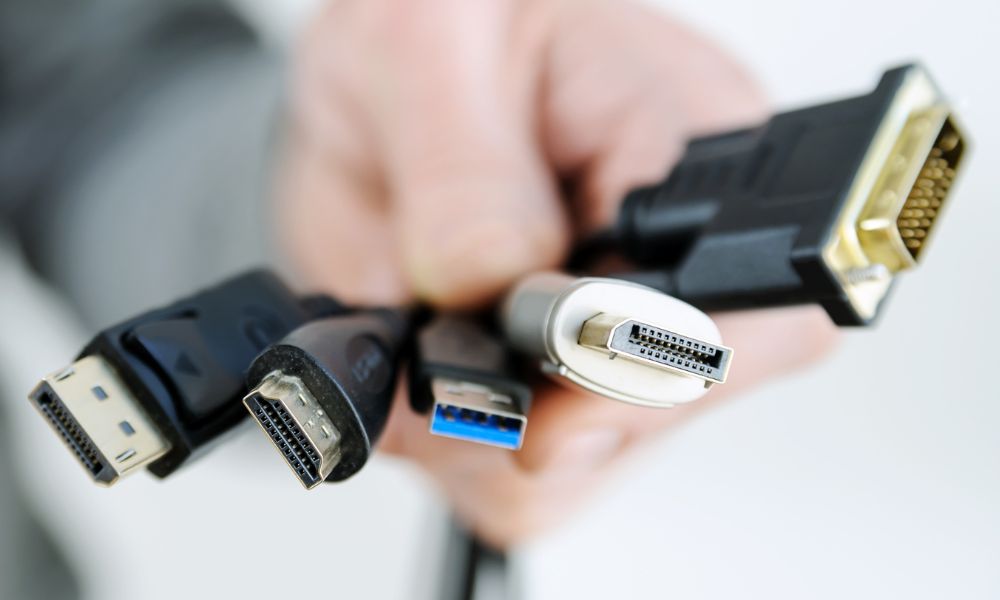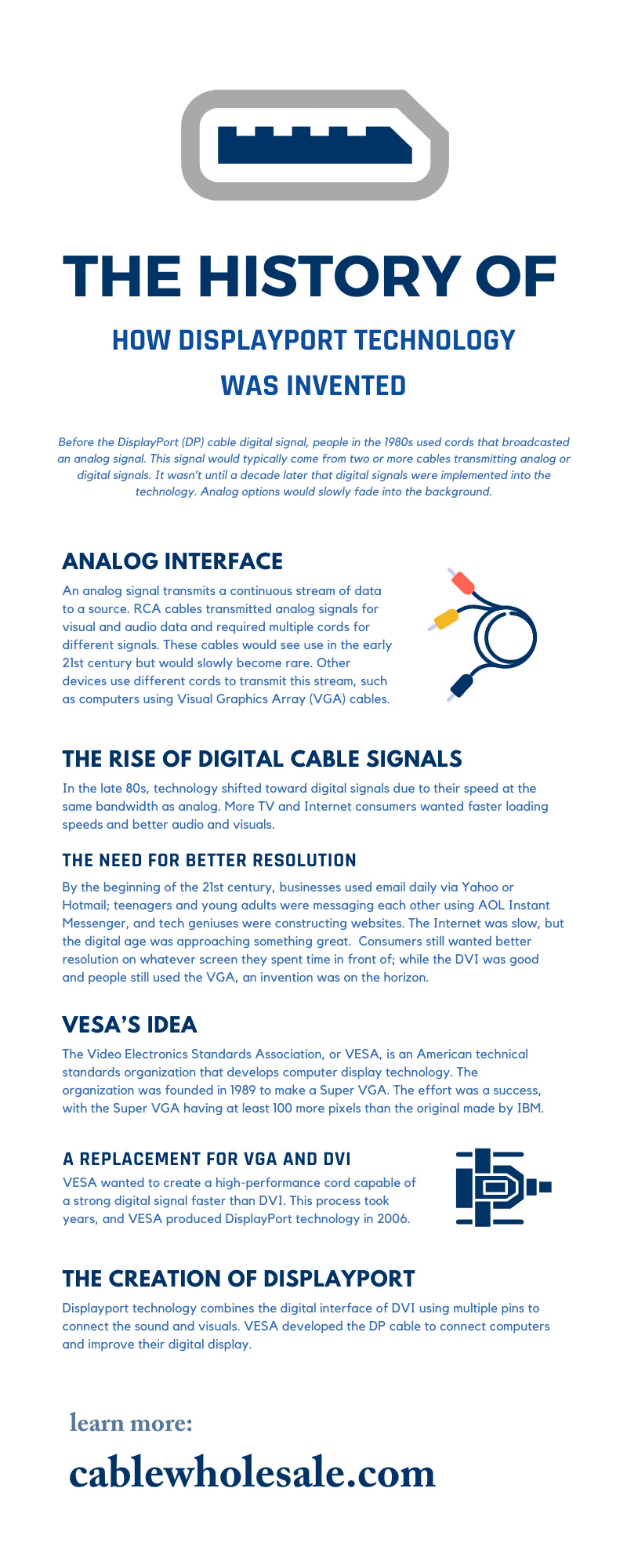
Networks worldwide use cables to connect devices and transfer data. DisplayPort technology is common in many networks and has an interesting history that can help us comprehend its value. Read on to learn the history of DisplayPort technology and why many people continue to use it.
What Was Used Before DisplayPort?
Before the DisplayPort (DP) cable digital signal, people in the 1980s used cords that broadcasted an analog signal. This signal would typically come from two or more cables transmitting analog or digital signals. It wasn’t until a decade later that digital signals were implemented into the technology. Analog options would slowly fade into the background.
Analog Interface
An analog signal transmits a continuous stream of data to a source. RCA cables transmitted analog signals for visual and audio data and required multiple cords for different signals. These cables would see use in the early 21st century but would slowly become rare. Other devices use different cords to transmit this stream, such as computers using Visual Graphics Array (VGA) cables.
Numerous pins and connectors join the AV features between devices. The structure of this cord using pins would see more use in later technology, eventually leading to the DP cable. Before then, a shift occurred from analog technology to digital interfaces.
The Rise of Digital Cable Signals
In the late 80s, technology shifted toward digital signals due to their speed at the same bandwidth as analog. More TV and Internet consumers wanted faster loading speeds and better audio and visuals. The average office worker used a computer that relied on analog signals from VGA cables, but this signal was slow and grainy.
The Digital Visual Interface cable became available in 1999, and many people used its digital signal for a clearer image on the screen. As new software and hardware emerged, DVIs became common among millions of users. Still, consumers wanted something better.
The Need for Better Resolution
As digital technology grew, more people relied on the Internet to perform various tasks. By the beginning of the 21st century, businesses used email daily via Yahoo or Hotmail; teenagers and young adults were messaging each other using AOL Instant Messenger, and tech geniuses were constructing websites. The Internet was slow, but the digital age was approaching something great.
Consumers still wanted better resolution on whatever screen they spent time in front of; while the DVI was good and people still used the VGA, an invention was on the horizon.
VESA’s Idea
The Video Electronics Standards Association, or VESA, is an American technical standards organization that develops computer display technology. The organization was founded in 1989 to make a Super VGA. The effort was a success, with the Super VGA having at least 100 more pixels than the original made by IBM. VESA would later work on more projects to push the boundaries of display technology’s capabilities.
A Replacement for VGA and DVI
The combination of the growing digital technology and the display standards made by VESA put a plan in motion to replace the current display technology of VGA and DVI. VESA wanted to create a high-performance cord capable of a strong digital signal faster than DVI. This process took years, and VESA produced DisplayPort technology in 2006.
The Creation of DisplayPort
Displayport technology combines the digital interface of DVI using multiple pins to connect the sound and visuals. VESA developed the DP cable to connect computers and improve their digital display. With its capabilities and reliability, the technology would exceed the abilities of other devices besides DVI, VGA, SCART, and RGB Component.
Capabilities
Many people flocked to DisplayPort cables after its production because it was the first of its kind. DP technology was the first display interface that relied on packetized data transmission. Before the DP cable, people relied on USB and Ethernet for similar data packet transfer.
The small data packets, called micro packets, transfer a clock signal that creates an internal rhyme of oscillation between high and low frequencies. They transfer more data with each packet sent and create a better resolution.
The previous digital and video display solely transferred video signals or required multiple cords to transmit audio and visual signals together. DP technology can transmit both signals simultaneously or separately using one cable and the pins in its ends. While this was a great advancement in computer technology, HDMI technology was also on the rise.
DP vs. HDMI
High-Definition Multimedia Interface (HDMI) is a digital audio, video, and data connector. The HDMI was released in 2002, four years before DisplayPort technology. Countless people use HDMI for various tasks, such as connecting televisions to personal devices. Developers built the HDMI to replace the analog signal with its digital signal and offer better speed and connectivity than analog devices.
Although both have similar capabilities and appearances, they excel in their own areas. DP cables aim to improve display standards for computers, which it achieves through resolution and micro packets. HDMI aims to transmit digital signals to HD TVs as a replacement for the standard analog setup. Both cords have niche abilities but function well within their fields and live up to the expectations of developers.
Future Plans for the Technology
After its release in 2006, the development of future versions of the DP cable occurred after more people used them for better resolution. Versions 1.0, 1.1, and 1.1a were ratified in the two years that followed, allowing a 10.8 Gbps data rate. For almost a decade afterward, VESA produced more versions with increased bandwidth and additional features to the standard. In 2018, version 2.0 launched with major updates, including resolution display and the type it will support, such as 4K and 8K.
The DisplayPort’s past leads into a present where the device is common. From its original purpose of replacing past interfaces for computers, this technology continues to enhance the resolution of computers. Its use will continue, as more versions are likely on the horizon. Consider the history of how DisplayPort technology was invented to understand its value. Browse CableWholesale for these great devices and the best wholesale stock available.




